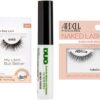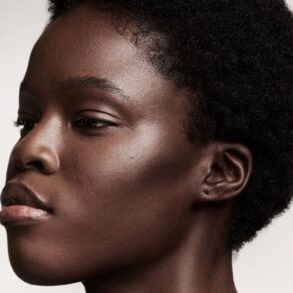
Created and marketed in 1959 as a teenage fashion doll alternative to baby dolls — and the star, of course, of the critically acclaimed box office blockbuster — Barbie has not only driven a cultural conversation on gender and feminism but also a desire to look like the doll itself. And now that’s more possible than ever (if not controversial), in almost every way except making human feet permanently arched.
Rachel Evans, a well-known Barbie lookalike in the U.K., has achieved her self-stated goal of being “a human doll … now I am Barbie 24/7,” as she states on her website, rachelevanstv.com, through 35 facial injection procedures. Wearing a pink and white plaid dress and hat akin to Barbie’s (Margot Robbie) traveling look in the movie, Evans explains her fixation in a Zoom interview with The Hollywood Reporter, saying that she was bullied as a child, resulting in a broken nose: “I knew I would feel happier if it was more Barbie-like,” she says. Over nearly a decade, starting with Botox, Evans strove to achieve her goal look of Barbie: “I’ve had every inch of my face injected. People say I look dramatically different. It’s been a very long process … to reshape my face and to use the Barbie face as the aesthetic ideal for what I wanted to achieve.”
She has appeared in Plastic Surgery Knifemares, the documentary Hooked On The Look and First Dates, a U.K. dating show. Evans, 53, has also written and self-published an autobiography called Inside The Studio With Rachel: My 15 Year Body Transformation. Her notoriety has made her open to some hostility toward her Barbie-ness. “I’ve had hate in real life, people threatening me, like it’s hate discrimination. I would sort of feel like people are projecting their dislike or their misunderstanding of me,” she says, adding, “I’ve always had the kindness and the personality of Barbie, so any hate, I would pray for them. That took me a while.”
Meanwhile, in Los Angeles, Marcela Iglesias has taken her love of Barbie to OnlyFans, marketing herself as “The Human Barbie.” “My obsession with the Barbie persona started with my mother in Argentina, where I was born,” she says. “My mother never bought me a Barbie doll. She felt that the doll was not appropriate for little girls to play with.” When she moved to America, the image of Barbie inspired her to leave behind her mother’s perspective. “So I came here to Hollywood and I’m thinking, wig, special effects, makeup, clothing — now I can be the real Barbie,” Iglesias explains of her evolution in appearance from arriving in the U.S. at 20, including a breast-augmentation surgery that she underwent last year. “I can be whoever I want to be.”
For the first 10 years she was in the U.S., Iglesias was trying to make ends meet for herself and her son. “I was working three, four jobs — telemarketing, waitress, nanny. I was doing everything that I could to support my son because my first marriage didn’t end up well,” she says. “So I left my home and basically I was taking care of my son by myself.” She says she held on to the Barbie message, as depicted in the doll’s array of professions, that has been communicated to generations of little girls and teenagers, that you can be and do anything. “The message that Ruth Handler said, ‘Everything is possible. You could be the best version of yourself,’” she says of the founder and the doll figure that empowered and motivated her. She is currently pursuing a career in music, with talk-show hosting as a personal goal.
As of yet, Evans hasn’t monetized her Barbie appearance, explaining that her agent has advised that “lookalike work is ‘niche’ but we hope the Barbie movie will change that.” Iglesias, on the other hand, claims she has made around $450,000 in total over the years from filmed appearances as Barbie, OnlyFans and Plastics of Hollywood, “a lifestyle brand for those who and are proud of their surgical transformations,” as stated on her wig-selling website. She also gives talks about her life story to inspire “others to follow their dreams, especially for the Latino community.”
These days, some plastic surgeons are marketing packages promising to turn women in Barbies. One of them, Dr. Scott Blyer of Cameo Surgery Center in Long Island, New York, charges $120,000 for the “Dream Surgery.” Says Dr. Blyer: “You get picked up in a pink Corvette, get your hair blonde and your pink nails done. It comes with lymphatic massages after the surgery,” which includes a $19,000 tummy tuck, $16,500 breast implants and $4,500 neck liposuction. “Some people want lipo 360 with the BBL [Brazilian butt lift], some want a tummy tuck, some want a breast lift,” he says. “On their face, we can enhance their lips with fillers. We can make adjustments to their nose, with rhinoplasty or even a non-surgical rhinoplasty.” Dr. Blyer, who is certified by American Board of Cosmetic Surgery and two other boards, stresses that the procedures are not simultaneous and that his team does “limit our surgeries to be less than six hours.”
When asked why some women want to have this procedure, he offers his own theory: “Maybe they just feel like this is their Barbie inside and they just want to finally have the inside meet the outside.” Business is on an uptick, no doubt due to the movie. “This is definitely hot and we are getting a lot of inquiries from other countries; we’re doing virtual consultations,” Dr. Blyer says. He is also willing to turn males into Barbie’s counterpart, the Ken doll, for $110,000. “We just recently had a man from Ohio sign up for the Ken Package,” Dr. Blyer says of the procedures that include liposuction, six-pack etching, jawline filler and teeth whitening, on top of being chauffeured to and from surgery in a Corvette in a color of their choosing. “[This client] was brave enough to say, I want to [get a] Ken makeover. Today, I saw three male consults.”
Dr. Gregory A. Greco, the president of the American Society of Plastic Surgeons, warns that “luring patients with promotional advertising that subjects them to a series of surgical procedures and quite likely unobtainable goals or expectations walks an ethical tightrope.” He references a procedure that is currently experiencing an uptick from Barbie and advises the usual precautions. “Phrases such as Barbie Botox, or trapezius ‘trap tox,’ is trending and offers a slimmer elongated neckline. This procedure is possible assuming the patient and provider have realistic goals and the medical procedure, risks, benefits and expectations have been fully explained. Any surgical procedure requires full informed consent and shared decision making,” he says, adding, “The surgeon should be a credentialed board-certified surgeon by a reputable board that is recognized by the American Board of Medical Specialties.”
The human Barbies are mostly basking in Greta Gerwig’s movie as the cultural moment they’ve been waiting for. “It’s a work of genius,” Evans says. Iglesias was struck by the artistry of the film: “I think [the] aesthetic looks amazing.”
All in all, though, both Barbie lookalikes truly enjoyed seeing their idol on the big screen. “It’s multifaceted, but it’s exceptional,” says Evans. “You’ll feel the love and then you’ll want to share it. So that’s what it meant for me.”
This post was originally published on this site be sure to check out more of their content.








